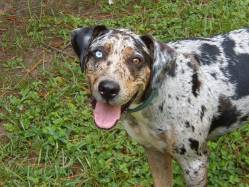Skip to comments.
Did Carolina Dogs Arrive With Ancient Americans?
National Geographic ^
| March 11, 2003
| Brian Handwerk
Posted on 03/28/2006 11:00:20 AM PST by RegulatorCountry
Humans and dogs enjoy a prehistoric relationship, a longstanding bond with its origins in a time when dogs as we know them evolved from wild animals into our domesticated companions.
Now, a canine living in a manner similar to that of dogs from those ancient days may have been discovered in isolated stretches of longleaf pines and cypress swamps in the American Southeast.
The Carolina Dog, a familiar-looking animal long known in the rural South as the "yaller dog," may be more than the common mutt that immediately meets the eye. I. Lehr Brisbin, Jr., Senior Ecologist at the University of Georgia's Savannah River Ecology Lab, believes that these animals may be America's most primitive dogs.
(Excerpt) Read more at news.nationalgeographic.com ...
TOPICS: Education; History; Local News; Miscellaneous; Outdoors; Pets/Animals
KEYWORDS: agriculture; animalhusbandry; carolinadog; carolinadogs; dixie; dixiedingo; dog; dogs; domestication; godsgravesglyphs; helixmakemineadouble; nagpra; northcarolina; precolumbian; southcarolina
Navigation: use the links below to view more comments.
first 1-20, 21-40, 41-49 next last
I saw the National Geographic special the other day, found it interesting, and thought others might find it interesting as well.
To: RegulatorCountry
2
posted on
03/28/2006 11:01:35 AM PST
by
Mikey_1962
(I grew up in a slum, when I got to college it had become a "ghetto".)
To: Mikey_1962
"Ole Yeller?"
Apparently. Those old mutts might be older than we thought, lol.
To: RegulatorCountry
Don't know about "yaller dogs," but found this information after my daughter got a Catahoula:
Once called a "Catahoula Cur," the foundation of the Louisiana Catahoula Leopard Dog came into existence through chance breeding and from some planned breeding. The Indians in and around Louisiana used the Red Wolf, which then roamed Louisiana during this period, to locate game, much in the same manner as hunters use their dogs today. Hernando DeSoto had traveled from Florida into Louisiana, bringing with him the "War Dogs" that had made the journey to the New World. The breeds that were referred to as War Dogs were the Greyhound and the Mastiff. Research has shown that the Mastiff type of dog that accompanied him was probably those known as the "Alano Mastiff" of Spain, which are now extinct. These Mastiffs had a reputation of being able to pull down very large game with ease. DeSoto utilized their abilities to persuade the Indians to provide information on the whereabouts of Gold and Treasure. Mostly those already owned by the Indians.
After suffering defeat in battle, DeSoto abandoned his War Dogs which were allowed to roam freely. They bred and interbreed with each other along with the Red Wolf. The offspring of the various breedings were then used by the Indians, and became known as the "Wolf Dog." The Wolf Dog, which is mentioned in Louisiana History, as well as most history books covering this era, was the name given to them by Henri Tonti during one of his visits to Louisiana.
By the early 1700's the French had started arriving in Louisiana. Hearing the stories of Tonti of the abundance of game in Louisiana the French brought with them a dog known as the "Bas Rouge," or Red Stockings. This dog has also been called the "Berger de Beauce." Today that very dog is known as the Beauceron. The French bred their dogs with those of the Indians' Wolf Dog, and together these four canines contributed to the inception of the Catahoula that we know today.

4
posted on
03/28/2006 11:08:47 AM PST
by
colorcountry
(Some folks wear their halos much too tight)
To: RegulatorCountry
I copied the article for my neighbor. She "rescued " a dog from the pound that looks exactly like the one depicted. I had often thought it had Dingo lines...... maybe I was right.
5
posted on
03/28/2006 11:12:35 AM PST
by
bert
(K.E. N.P. Slay Pinch)
To: colorcountry
Am I mistaken, or doesn't having two different eye colors indicate chimerism, having two distinct genetic makeups? The only other breed I've seen with eyes like that is the Australian Shepherd.
To: SunkenCiv
7
posted on
03/28/2006 11:22:05 AM PST
by
indcons
(The MSM - Mainstream Slime Merchants)
To: RegulatorCountry
In the article, the physical similarity of the Carolina Dog to a breed from an isolated part of Korea was noted. If DNA studies show these two breeds to be very close genetically, it would support the contention of mainstream historians and archaeologists that the American Indians are predominantly of Northeast Asian origin.
To: Wallace T.
"If DNA studies show these two breeds to be very close genetically, it would support the contention of mainstream historians and archaeologists that the American Indians are predominantly of Northeast Asian origin."
Why would they have been wiped out across the entire continent, other than in the isolated pine barrens, swamps and barrier islands of NC, SC, GA and northern FL, though? This region has not been free, historically speaking, of large predators, such as wolves and panthers (referred to by the Scots-Irish as "painters").
To: RegulatorCountry
I didn't know Australian Shepherds were chimeric. When I first saw a Catahoula I assumed they were part Australian Shepherd. Not only do they resemble them, but Catahoulas are used in herding cattle too.
10
posted on
03/28/2006 11:32:25 AM PST
by
colorcountry
(Some folks wear their halos much too tight)
To: colorcountry
"I didn't know Australian Shepherds were chimeric."
I don't know it for absolute certain, either. But, there are two causes for this that I am aware, which would be eye injury or chimerism, and I don't think every Australian Shepherd I've ever seen had an eye injury. Maybe there are other causes, but I'm not aware of them.
To: colorcountry
The most vicious animal I have ever encountered was a Catahoula ...
I hope never to see another one.
12
posted on
03/28/2006 11:39:25 AM PST
by
caryatid
(Jolie Blonde, 'gardez donc, quoi t'as fait ...)
To: RegulatorCountry
I think it's just a genetic trait since they can breed for it. I did find this snipette:
"It is told, that Native Americans referred to the dogs with mixed eyes as "spirit dogs", and considered them a gift and of great honor."
13
posted on
03/28/2006 11:51:23 AM PST
by
colorcountry
(Some folks wear their halos much too tight)
To: indcons; pcottraux; blam; FairOpinion; StayAt HomeMother; Ernest_at_the_Beach
Thanks indcons. Not a ping, because we've had a topic or two about Carolina dogs, but will add it to the catalog, as well as ping pcottraux for a possible cryptobiology ping.
To all -- please ping me to other topics which are appropriate for the GGG list. Thanks. Please FREEPMAIL me if you want on or off the
"Gods, Graves, Glyphs" PING list or GGG weekly digest
-- Archaeology/Anthropology/Ancient Cultures/Artifacts/Antiquities, etc.
Gods, Graves, Glyphs (alpha order)
14
posted on
03/28/2006 11:52:45 AM PST
by
SunkenCiv
(Yes indeed, Civ updated his profile and links pages again, on Monday, March 6, 2006.)
To: colorcountry
Their stare is sort of disconcerting. It's intense, like any herding breed, but the two different eye colors really puts the whammy on you, lol. I can see why the tribes in the area would refer to them as "spirit dogs."
To: RegulatorCountry
Why would they have been wiped out across the entire continent, other than in the isolated pine barrens, swamps and barrier islands of NC, SC, GA and northern FL, though? I don't know, but one possibility is that the Carolina Dogs represent the oldest canine population, in terms of residence on this continent. If immigration from Northeast Asia was continuous over several thousand years, later arrivals might have brought different breeds which either overwhelmed and assimilated any Carolina like canines elsewhere in what would become the U.S. and Canada. If the Bering Strait "bridge" during the Ice Age theory is correct, then the coastal Southeast would represent the opposite end of the continent from Alaska. Newer migrants, dog and human alike, may not have penetrated these areas in the pre-Columban era.
To: caryatid
Really? My daughter's is very loving and sweet. I have a standard poodle that is the most kind, loving dog I have ever met....but I've had others tell me that poodles are a vicious breed. LOL
 Same dog different hairstyle....
Same dog different hairstyle.... 
17
posted on
03/28/2006 11:54:57 AM PST
by
colorcountry
(Some folks wear their halos much too tight)
To: RegulatorCountry
18
posted on
03/28/2006 12:12:11 PM PST
by
blam
To: SunkenCiv; Angelas; presidio9; Idisarthur; Hegemony Cricket; A knight without armor; new cruelty; ..
Ah, why not?

19
posted on
03/28/2006 12:14:30 PM PST
by
pcottraux
(It's pronounced "P. Coe-troe.")
To: blam
Navigation: use the links below to view more comments.
first 1-20, 21-40, 41-49 next last
Disclaimer:
Opinions posted on Free Republic are those of the individual
posters and do not necessarily represent the opinion of Free Republic or its
management. All materials posted herein are protected by copyright law and the
exemption for fair use of copyrighted works.
FreeRepublic.com is powered by software copyright 2000-2008 John Robinson

 Same dog different hairstyle....
Same dog different hairstyle.... 
